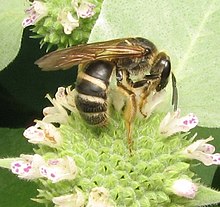Type a search term to find related articles by LIMS subject matter experts gathered from the most trusted and dynamic collaboration tools in the laboratory informatics industry.
| Lasioglossum | |
|---|---|

| |
| Scientific classification | |
| Domain: | Eukaryota |
| Kingdom: | Animalia |
| Phylum: | Arthropoda |
| Class: | Insecta |
| Order: | Hymenoptera |
| Family: | Halictidae |
| Tribe: | Halictini |
| Genus: | Lasioglossum Curtis, 1833 |
| Subgenera | |
|
see text | |

The sweat bee genus Lasioglossum is the largest of all bee genera, containing over 1800 species in numerous subgenera worldwide.[1][2] They are highly variable in size, coloration, and sculpture; among the more unusual variants, some are cleptoparasites, some are nocturnal, and some are oligolectic. Most Lasioglossum species nest in the ground, but some nest in rotten logs.[3]
Social behavior among species of Lasioglossum is extraordinarily variable; species are known to exhibit solitary nesting, primitive eusociality, and social parasitism. Colony sizes vary widely, from small colonies of a single queen and four or fewer workers to large colonies of >400 workers and perennial life cycles.[4]
The genus Lasioglossum can be divided into two informal series based on the strength of the distal veins of the forewing.[5] The Lasioglossum series (or strong-veined Lasioglossum) is mostly composed of solitary or communal species, even if some species like L. aegyptiellum show signs of division of labour indicative of eusociality.[1]

The Hemihalictus series (or weak-veined Lasioglossum) includes species with a wide range of sociality.[6][4] The Hemihalictus series is composed of species which are solitary, communal, primitively eusocial, cleptoparasitic, or socially parasitic.[1] Eusocial species may have small colonies with only one or a few workers or large colonies with dozens of workers. Large colony sizes occur in L. marginatum, which forms perennial colonies lasting five or six years, with hundreds of workers; this species is the only halictine bee with perennial colonies.[4]
A list of subgenera (modified from Michener's Bees of the World):
Lasioglossum series: Australictus, Callalictus, Chilalictus, Ctenonomia, Echthralictus, Glossalictus, Homalictus, Ipomalictus, Lasioglossum s. str., Leuchalictus, Oxyhalictus, Parasphecodes, Pseudochilalictus, Rubrihalictus, Urohalictus.
Hemihalictus series: Acanthalictus, Austrevylaeus, Biennilaeus, Capalictus, Dialictus, Eickwortia, Evylaeus, Hemihalictus, Rostrohalictus, Pyghalictus, Sphecodogastra.
Subgeneric classification of Lasioglossum remains controversial, with disagreement among experts on the number and extent of subgenera.
Two of the better-known species are the European Lasioglossum malachurum and the North American species Lasioglossum zephyrus.